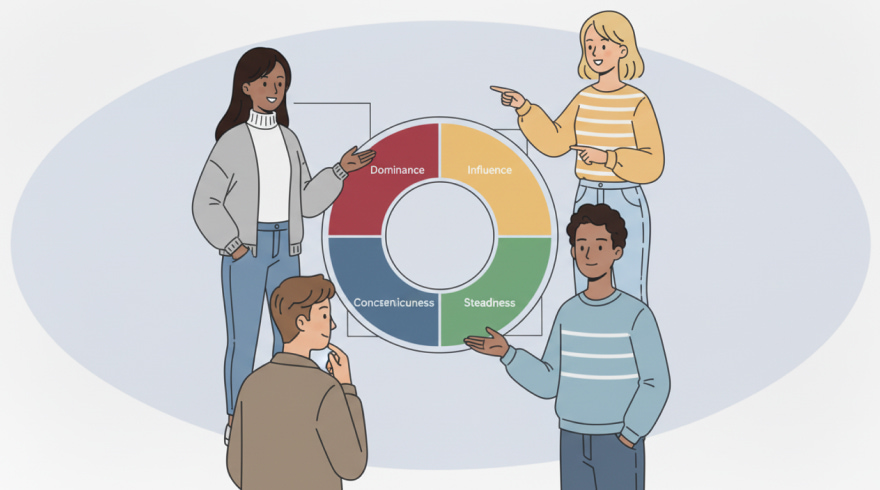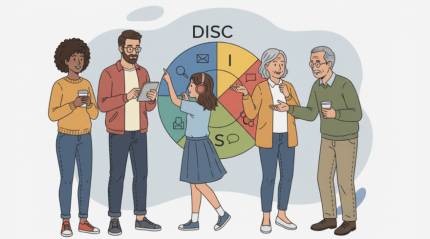The Ultimate Guide to Discovering Your DISC Style for Free
- 29 October 2025

Take DISC Personality Assessment Online
Get StartedWhat DISC Measures and Why It Matters
Understanding how you prefer to communicate, decide, and collaborate can change the way you work and live. The DISC model maps observable behavioral tendencies across Dominance, Influence, Steadiness, and Conscientiousness, offering a practical lens for self-awareness without dense jargon. Rather than assigning value judgments, this framework highlights strengths, blind spots, and situational strategies that help you adapt with intention.
Enthusiasts often explore accessible options long before investing in premium programs, and many discover that DISC personality test for free resources deliver a surprisingly robust introduction to the model without hurdles. You can use the results to reflect on how you handle pressure, where you gain energy, and which environments bring out your best. That clarity supports better conversations, fewer misunderstandings, and faster alignment with colleagues or partners.
Practical outcomes show up quickly when you translate insights into daily habits. Teams see smoother handoffs, managers tailor coaching more effectively, and individuals gain language to articulate needs with empathy. For first-time learners who prefer minimal friction, a straightforward starter path such as a free DISC personality test can illuminate signature patterns and kick-start constructive change. With even a short profile, you can connect behaviors to outcomes, then experiment with small adjustments that compound over time.
- Build a shared vocabulary for feedback and coaching.
- Spot stress signals earlier and choose healthier responses.
- Design workflows around natural strengths and pacing.
- Navigate difficult conversations with greater tact and timing.
How Free Assessments Work and What You’ll Gain
Most introductory questionnaires highlight preferences in pace, focus, and communication, then translate those answers into a style snapshot. You’ll usually see a primary tendency plus secondary influences, with quick tips for collaboration and conflict. While brevity is the point, the better instruments still anchor their items in validated constructs and provide clear, plain-English feedback.
When you want an offline option for classrooms or workshops, some providers offer printable files that complement short surveys, and those can pair nicely with a DISC personality test free download when internet access is limited. The process stays simple: answer honestly based on typical behavior, not idealized traits, and let patterns emerge. Good tools emphasize observable actions, which keep the guidance practical and behaviorally specific.
After you receive your summary, look for takeaways you can test immediately. You might adjust how you open meetings, shift your email tone, or change the way you ask for updates. For learners who prefer concise direction, a compact free DISC personality assessment often provides bite-sized coaching tips that are easy to trial in real scenarios. Over a few weeks, track what improves, decision speed, rapport, or reduced rework, and refine your approach accordingly.
- Set one experiment per week tied to a single behavior.
- Share your summary with a colleague and ask for feedback.
- Note triggers that escalate stress and pre-plan alternatives.
- Rotate your communication channel to suit your audience.
The Four Styles Explained with Real-World Applications
Each DISC style shows up through pacing, priority, and problem-solving tendencies. People with higher Dominance often prefer directness and decisive action, leaning into goals and guardrails. Colleagues high in Influence tend to energize groups, ideate quickly, and champion possibilities. Those with elevated Steadiness usually value consistency, teamwork, and thoughtful support, while Conscientiousness-oriented teammates maintain standards, analyze tradeoffs, and prize accuracy.
Labels aren’t cages, and nuanced blends are the norm. You’ll see situational shifts under stress or when stakes rise, so the most helpful strategy is adaptive collaboration. For learners exploring a broad introduction that balances clarity with convenience, you might try a DISC personality types test free to map core tendencies before diving deeper. Once you recognize the patterns, you can tailor meeting structures, assign roles by strength, and calibrate feedback to the receiver’s preference.
Leadership implications are substantial in hybrid and cross-functional environments. Decision pathways speed up when managers align message formats, timelines, and autonomy with the makeup of the group. Practitioners who prefer a minimal barrier approach sometimes start with something like a DISC test personality free tool to gather baseline insights across a department. That shared snapshot becomes a springboard for norms around communication, escalation, and project cadence.
- Match task complexity with a person’s appetite for detail or brevity.
- Balance brainstorming with structured evaluation checkpoints.
- Codify collaboration rules: channels, response times, and handoffs.
- Use retrospectives to adjust norms as the team evolves.
Choosing the Right Free Tool and Reading the Results
Not all brief questionnaires are created equal, so it helps to know what you’re looking for before you click start. Accuracy improves when items are behaviorally anchored, instructions are clear, and the scoring logic avoids leading statements. You also want useful outputs, language you can apply to meetings, emails, and decision rituals right away, rather than vague descriptors that sound flattering but offer little guidance.
Some learners prefer a web-first experience with instant reports, especially when considering options such as a DISC personality test online free that delivers quick insights in minutes. Others favor more structured instructional text, reflections, and worksheets, which can pair well with a free online DISC personality test that includes practical coaching prompts. Whatever you choose, treat the first readout as a working hypothesis and validate it with real feedback from people who know you well.
To help you scan key differences at a glance, use the guide below to weigh time, output depth, and best use cases for getting started. Then, test-drive one option for yourself before rolling it to a group, noting whether the language resonates and whether the advice translates into observable behavior change.
| Option | Time | Output Depth | Best For |
|---|---|---|---|
| Quick Screen | 5–7 minutes | Concise style labels and tips | First-time users, icebreakers |
| Standard Snapshot | 10–12 minutes | Primary/secondary styles with scenarios | Individual contributors, managers |
| Team Overview | 15–20 minutes | Aggregate map plus collaboration norms | Workshops, cross-functional teams |
- Validate personal results by asking colleagues for one agreement and one surprise.
- Apply a single recommendation per week to measure impact clearly.
- Document what lands well in your culture and what needs translation.
How to Take the Assessment for Reliable, Actionable Insights
Good data begins with honest answers that reflect your typical behavior, not an idealized version. Aim for speed over perfection so you capture instinct, and choose a quiet moment without interruptions. If an item feels situational, select the response that aligns with your default when deadlines loom or stakes rise, because those moments reveal the patterns that matter most.
Once you receive your results, translate insights into experiments you can run in the next meeting, one-on-one, or project kickoff. People who want to test-drive a group workflow sometimes coordinate around a free DISC personality testing option to establish shared language before deeper training. The key is to avoid stereotyping and instead focus on adaptable behaviors: slower pacing when alignment wobbles, or faster decisions when the window for opportunity is narrow.
Reflection expands value over time. Set a simple plan: one behavior to increase, one to dial back, and one to monitor. Practitioners who prefer to keep costs light while learning can start with resources labeled as DISC personality free options to build a baseline. After a few cycles, evaluate what’s changed in your communication climate, fewer misunderstandings, crisper agendas, or smoother handoffs, and capture those wins to reinforce momentum.
- Schedule a 10-minute debrief with a peer after your first readout.
- Pick a single audience this week and adapt your message style.
- Track stress triggers and pre-plan a calming counter-behavior.
- Revisit your profile quarterly as roles and contexts shift.
FAQ: Answers to Common Questions
How accurate are short DISC questionnaires compared to longer versions?
Brief instruments can be surprisingly reliable when items are behaviorally specific and scoring is transparent, especially if you validate takeaways with real feedback. Practitioners seeking a no-cost entry point might try options categorized as DISC personality testing free to establish a preliminary baseline they can later refine with deeper tools.
Can I use a DISC snapshot for team development without formal training?
Yes, if you frame it as a conversation starter and pair it with clear norms that prevent labeling. After a pilot, you can translate insights into meeting rules, project protocols, and feedback rituals that elevate collaboration without adding bureaucracy.
What’s the best way to interpret blended styles?
Look beyond the headline to situational cues: how you respond under pressure, what energizes you, and where you hesitate. Use specific observations, tone, pace, questions asked, to choose the right adaptation in each context.
Is it okay to share my results with my manager or team?
Sharing can accelerate trust if you set expectations about how the data will be used and invite reciprocal transparency. For ongoing development, some people keep a short summary similar to a free DISC personality profile to guide one-on-ones and project kickoff conversations.
How often should I retake a DISC-style questionnaire?
Retest when your role changes significantly, your responsibilities expand, or your environment shifts. Stability is common, but new demands can highlight different facets of your behavior and suggest fresh adaptations.



